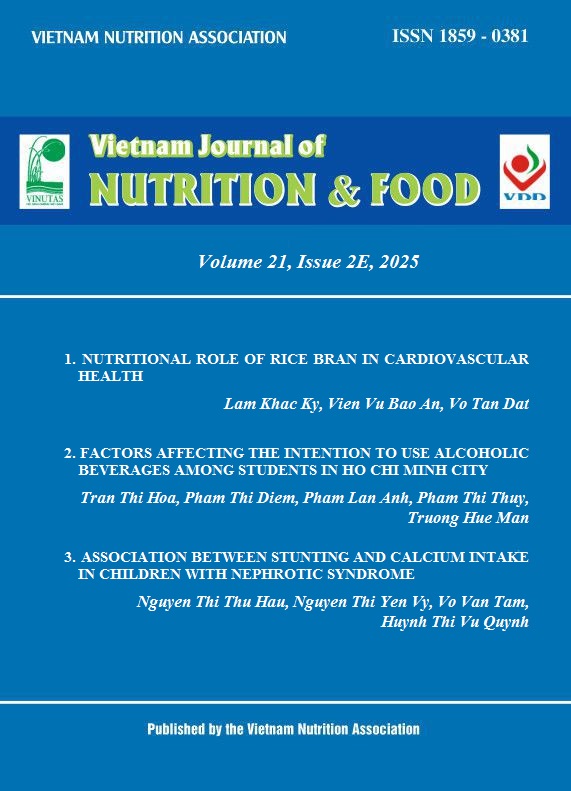NUTRITION STATUS OF THYROID CANCER PATIENTS UNDERGOING RADIOACTIVE IODINE ABLATION THERAPY
Nội dung chính của bài viết
Tóm tắt
Aims: This study aims to determine the characteristics of patients indicated for I-131 treatment following complete thyroidectomy. The findings will assist Vietnamese nutritionists in developing appropriate guidelines and intervention methods.
Methods: This cross-sectional study was conducted at Hanoi Oncology Hospital from April 2021 to December 2022. Body weight, height, arm and calf circumference were measured. Body mass index (BMI) was calculated, and Patient Generated Subjective Global Assessment (PG-SGA) was assessed. The 24-hour dietary recall was assessed in comparison to patient’s energy and protein daily requirements.
Results: Based on BMI, 15.3% of patients were overweight or obese, while 9.6% were malnourished. Arm and calf circumferences were effective indicators of malnutrition risk, similar to the PG-SGA. Despite 91.1% reporting no dietary changes, 40.3% experienced weight loss. Common symptoms included difficulty swallowing, loss of appetite, and fatigue. Dietary intake met 60.6 ± 24.6% of energy and 48.8 ± 20.6% of daily protein requirements.
Conclusions: A predominant rate of overweight-obesity (33.1%) was found in the thyroid cancer patients. Their energy and protein intake were inadequate. Dietary counseling is recommended to ensure iodine restriction, adequate nutrition, and prevent weight gain after I-131 treatment.
Từ khóa
Thyroid cancer, nutrition status, dietary intake, BMI, PG-SGA
Chi tiết bài viết
Tài liệu tham khảo
2. American Thyroid Association Guidelines Taskforce on Thyroid Nodules and Differentiated Thyroid Cancer; Cooper DS, Doherty GM, Haugen BR, et al. Revised American Thyroid Association management guidelines for patients with thyroid nodules and differentiated thyroid cancer. Thyroid. 2009;19(11):1167-214.doi: 10.1089/thy.2009.0110.
3. Huong DQ. Changes in urinary iodine concentration after implementing an iodine-restricted diet in patients with differentiated thyroid cancer who had surgery before treatment with I-131, in Faculty of Nursing. 2013, Thang Long University: Thang Long University.
4. Löser A, Ramke K, Grohmann M, et al. The impact of nutritional counseling on thyroid disorders in head and neck cancer patients after (chemo)radiotherapy: results from a prospective interventional trial. Strahlenther Onkol. 2022;198(2):135-148.
5. Harari AEB, Nishimoto S, Ituarte PHG, Yeh MW. Risk of Advanced Papillary Thyroid Cancer in Obese Patients. Arch Surg. 2012; 149(9):805–811.
6. Ferro-Luzzi A and James WP. Adult malnutrition: simple assessment techniques for use in emergencies. Br J Nutr. 1996; 75(1):3-10.
7. Gonzalez MC, Mehrnezhad A, Razaviarab N, et al. Calf circumference: cutoff values from the NHANES 1999-2006. Am J Clin Nutr. 2021;113(6):1679-1687.doi: 10.1093/ajcn/nqab0298.
8. Muscaritoli M, Arends J, Bachmann P, et al. ESPEN practical guideline: Clinical Nutrition in cancer. Clin Nutr. 2021 May;40(5):2898-2913. doi:10.1016/j.clnu.2021.02.005.
9. Bauer JS. Capra, and Ferguson M. Use of the scored Patient-Generated Subjective Global Assessment (PG-SGA) as a nutrition assessment tool in patients with cancer. Eur J Clin Nutr. 2002;56(8):779-785.
10. Sousa IM, Bielemann RM, Gonzalez MC, et al. Low calf circumference is an independent predictor of mortality in cancer patients: A prospective cohort study. Nutrition. 2020;79-80:110816. doi: 10.1016/j.nut.2020.110816.
11. Jung EH, Hiratsuka Y, Suh SY, et al. Association between mid-upper arm circumference and functional status in patients with advanced cancer. Clinical Nutrition Open Science. 2022;45:72-79. doi: :10.1016/j.nutos.2022.08.002.


